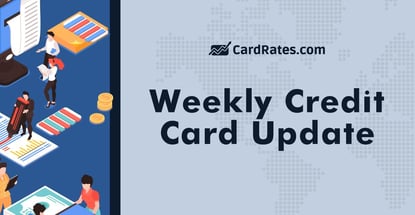For media inquiries on these stories and more, contact credit card expert and industry analyst Bill Hardekopf at (205) 985-9725 or billh@cardrates.com.
1. Visa’s Amazon Spat Shows Power is Shifting to Retailers in Fee Battle

Amazon’s latest spat with Visa shows big retailers, armed with a growing array of payment options, are gaining the upper hand in their power struggle with card providers. While Amazon may yet back down on the UK front, the dispute is a bad sign for the card industry.
Some analysts said it could presage a fight in the much bigger U.S. market. Credit cards dominated a third of North American ecommerce spending in 2020, but mobile payment options like Venmo and buy now, pay later financing plans are chipping away at their market share. While alternative payments have been growing for years, the pandemic accelerated a downward trend in credit card applications boosting the popularity of BNPL financing, especially among younger consumers. Credit cards’ share of North American e-commerce spending declined 7% last year, while BNPL’s share increased 78%, making it the fastest-growing form of payment.
• Story By: David Henry and Matt Scuffham, Reuters
2. Gen Z is Signing Up for Credit Cards Faster Than Any Generation

Many banks were forced to tighten their lending requirements at the height of the pandemic, and that included cutting back on approving consumers for new credit cards.
But a year later much has changed: credit card originations have nearly doubled to record levels, increasing from 8.6 million in Q2 2020 to 19.3 million in Q2 2021, according to credit bureau TransUnion’s Q3 2021 Quarterly Credit Industry Insights Report. The report also found that the youngest generation of consumers, Gen Z, is driving this credit card industry rebound with the biggest jump in credit card originations.
• Story By: Rabia Gursoy, CNBC
3. Target is Giving $15 Back with Every $100 Apple Gift Card Purchase

We know that hunting for deals this Black Friday is tougher than usual, but here’s one that’s guaranteed to be in stock: Target is giving away $15 Target gift cards with $100 in Apple gift card purchases.
And here’s a bonus tip: If you use a Target card, you can get an extra 5% back for another $5 in savings. The Apple gift card can be used to buy anything Apple sells, including subscriptions, movies, music, and of course, devices. The offer is good on any denomination as long as it adds up to at least $100. The offer is good until Saturday, November 27.
• Story By: Michael Simon, Macworld
4. Turkeys, Inflation, and the Ability to Repay Credit Cards

Inflation creates risk in the credit card business. One challenge credit card issuers will face next year is that rising costs will impact the consumer’s ability to repay. When it comes time to pay your monthly American Express, Discover, Mastercard, and Visa bills, you will probably pay less.
Note that credit card issuers have an opportunity since more credit will revolve. U.S. consumer revolving debt is now over $1 trillion, and the average interest rate charged is 14.54%. While the increased revenue creates opportunity, top credit card companies like Bank of America, Capital One, Citi, Chase, and Wells do not want to rely on more credit card revolvers because it is a risk indicator. Rising revolving debt indicates that households cannot extinguish their debts quickly.
• Story By: Brian Riley, Payments Journal
5. AmEx Pitched Business Customers a Tax Break That Doesn’t Add Up

In phone calls, emails and in-person meetings with thousands of business owners, American Express salespeople laid out the strategy. Use AmEx to pay your employees and suppliers, they said. You’ll have to pay a fee, but you’ll come out ahead. That’s because you can earn rewards on the transaction that can be converted into untaxed cash, while also deducting the transaction fees for tax purposes.
The pitch helped AmEx bring in billions of dollars of transaction volume since at least 2018, according to people familiar with the matter and documents reviewed by The Wall Street Journal. But there was a problem: The strategy relied on a shaky interpretation of how tax law treats rewards points. In July, a whistleblower filed a report with the Internal Revenue Service alleging that AmEx knowingly persuaded business owners to underreport their income and taxes.
• Story By: AnnaMaria Andriotis, Richard Rubin and Heather Haddon, The Wall Street Journal
6. Amazon Credit Cards Offering Up to $200 Welcome Bonus, 10% Back on Select Products

Until November 30, new and existing Amazon credit cardholders are in for an extra treat. If you’re interested in signing up for an Amazon credit card, you’ll earn an increased welcome bonus of either a $100 or $200 Amazon gift card immediately upon approval.
Additionally, both new and existing cardholders can take advantage of 10% back in rewards on eligible gift purchases.
• Story By: Brett Holzhauer, CNBC
7. Direct Credit Card Issuing Helps Small Banks, Credit Unions Compete with Larger FI Rivals

Long stuck with cookie-cutter credit issuing capabilities due to their size, staffing, partners and geographical limits, small financial institutions have been at a distinct disadvantage in the crowded credit card market.
But issuer processors like i2c are changing the dynamic, giving them direct issuing services and other tools needed to level the playing field against the biggest players in the game. Digital banking and card issuing platforms like i2c’s provide solutions that enable these players to do direct issuing without the internal investments and staffing requirements that card programs demand.
• Story In: PYMNTS
8. Pandemic Widens Mobile’s Lead as Preferred Way to Bank

Mobile banking was already the most popular method for American consumers to interact with their bank accounts before the Covid-19 pandemic struck. But since March 2020, the proportion of customers using mobile platforms has jumped 11 percentage points, the American Bankers Association found in a survey.
The proportion of customers for whom in-branch visits were the top option for banking fell by the same margin, 11 percentage points in the same time frame. About 10% of users preferred to visit a brick-and-mortar location post-Covid, compared with 21% before, according to the ABA. Online banking with a laptop or personal computer ranked second both pre- and post-Covid, with 24% of respondents preferring that method before the pandemic, and 26% since.
• Story By: Robin Bradley, Banking Dive
9. Attention Holiday Shoppers: The Pros and Cons of Retail Credit Cards

Retailers want you to sign up for and use their credit cards. They know if you have their cards in your wallet it increases the likelihood that you’ll spend more with them. So, expect to get pitched every time you check out this holiday season, both in store and online.
While having a store’s card may make sense for you, applying for credit can impact your credit score and overall finances, so it should never be done without careful consideration. You need to understand the terms, fees, and interest rate. Most retail credit cards have higher interest rates than traditional credit cards.
• Story By: Herb Weisbaum, Consumers’ Checkbook
10. There Will Be No Escaping Ghana’s New Levy on Electronic Transactions

Ghana’s finance minister Ken Ofori-Atta has announced that the government intends to introduce an electronic transaction levy (e-levy) in the 2022 budget. He said this was to “widen the tax net and rope in the informal sector”.
The proposed levy, which will come into effect on 1 February 2022, is a charge of 1.75% of the value of electronic transactions. It covers mobile money payments, bank transfers, merchant payments, and inward remittances. The originator of the transactions will bear the charge except for inward remittances, which will be borne by the recipient.
• Story By: PK Senyo, Quartz
11. ‘Reverse Robin Hood’ Is a Myth and Capping Interchange Fees Would Hurt the Poor

The claim that rewards credit cards benefit the rich at the expense of the poor has been trotted out many times by those who want to cap the fees charged to merchants by card issuers. Though the myth of this so-called “reverse Robin Hood” effect has been debunked repeatedly, it continues to resurface from the grave.
This is troubling for various reasons, not least because capping interchange fees would actually harm the poor the most.
• Story By: Julian Morris and Ben Sperry, The Hill
Advertiser Disclosure
CardRates.com is a free online resource that offers valuable content and comparison services to users. To keep this resource 100% free, we receive compensation for referrals for many of the offers listed on the site. Along with key review factors, this compensation may impact how and where products appear across CardRates.com (including, for example, the order in which they appear). CardRates.com does not include the entire universe of available offers. Editorial opinions expressed on the site are strictly our own and are not provided, endorsed, or approved by advertisers.





![3 FAQs: ATM Card vs. Debit Card vs. Credit Card ([updated_month_year]) 3 FAQs: ATM Card vs. Debit Card vs. Credit Card ([updated_month_year])](https://www.cardrates.com/images/uploads/2016/05/atm-card-vs-debit-card-vs-credit-card--1.png?width=158&height=120&fit=crop)
![What Card is in the Jennifer Garner Credit Card Commercial? ([updated_month_year]) What Card is in the Jennifer Garner Credit Card Commercial? ([updated_month_year])](https://www.cardrates.com/images/uploads/2018/05/jennifer-2.jpg?width=158&height=120&fit=crop)
![Can You Pay a Credit Card with a Credit Card? 3 Ways Explained ([updated_month_year]) Can You Pay a Credit Card with a Credit Card? 3 Ways Explained ([updated_month_year])](https://www.cardrates.com/images/uploads/2017/02/card-with-card-2.png?width=158&height=120&fit=crop)



![3 Key Differences: Charge Card vs. Credit Card ([updated_month_year]) 3 Key Differences: Charge Card vs. Credit Card ([updated_month_year])](https://www.cardrates.com/images/uploads/2017/03/charge-card-vs-credit-card.jpg?width=158&height=120&fit=crop)